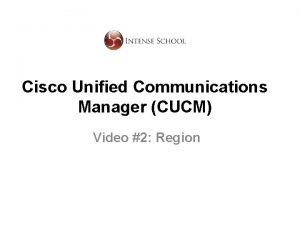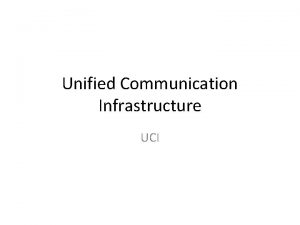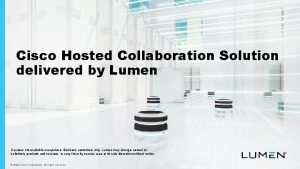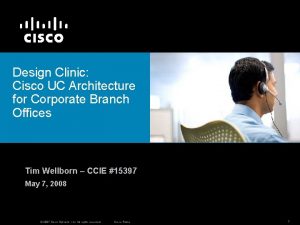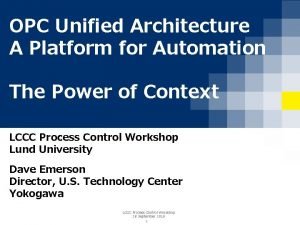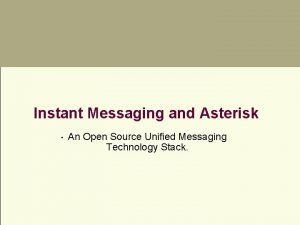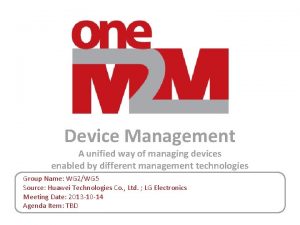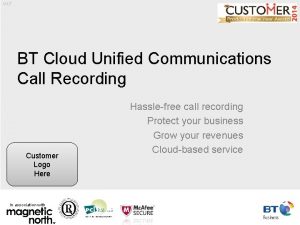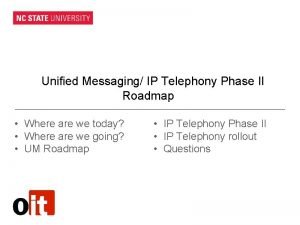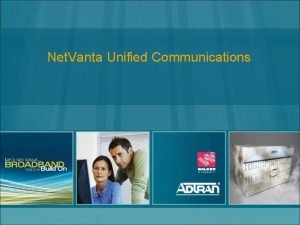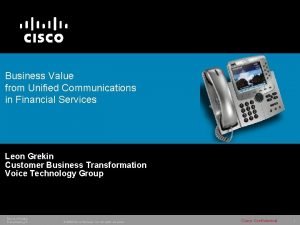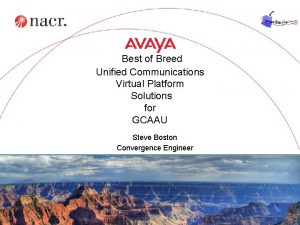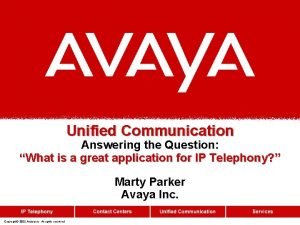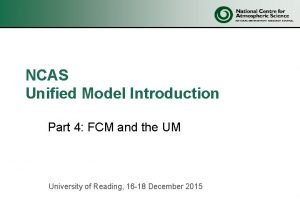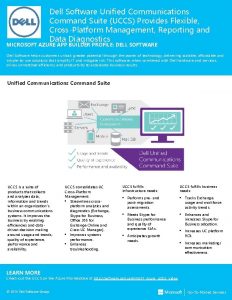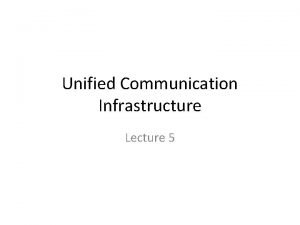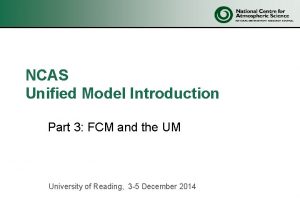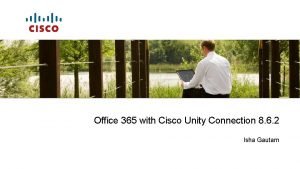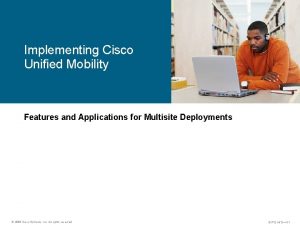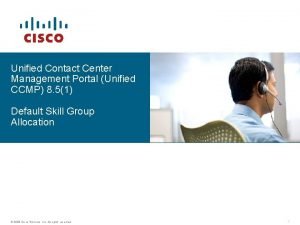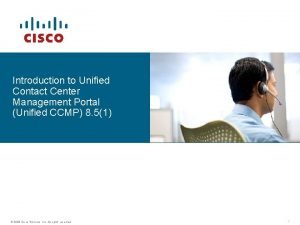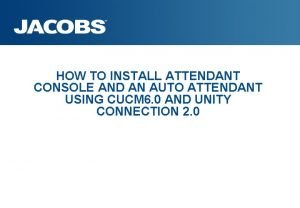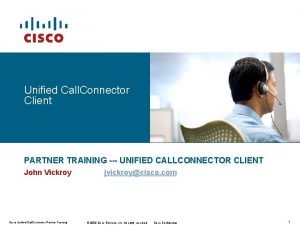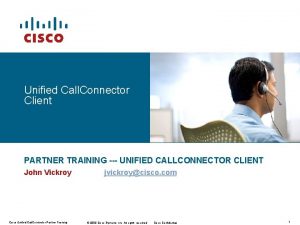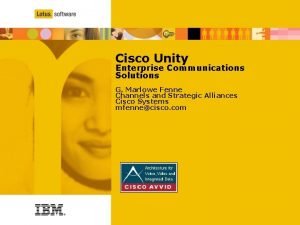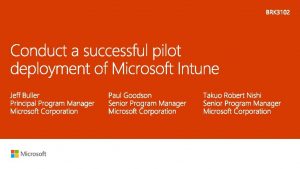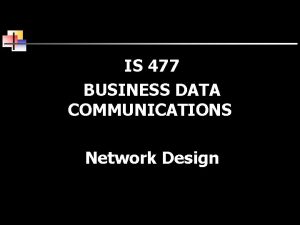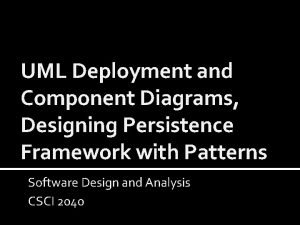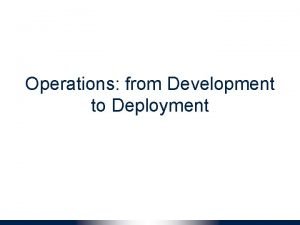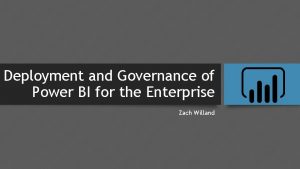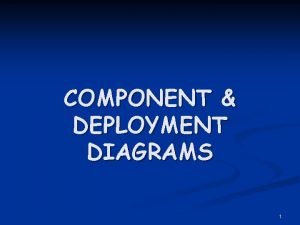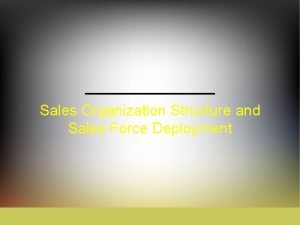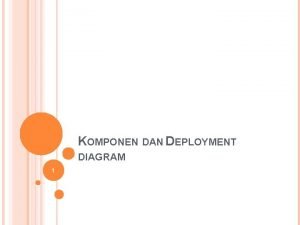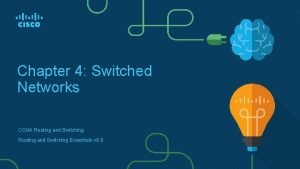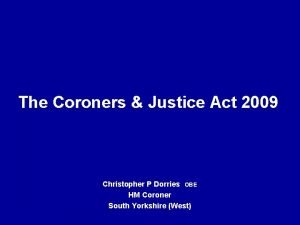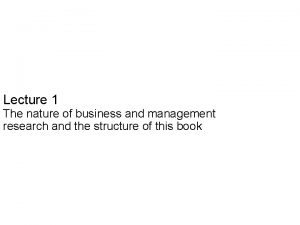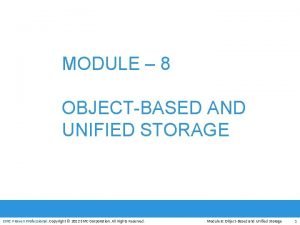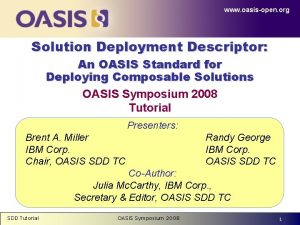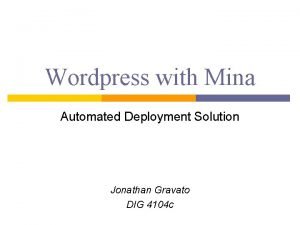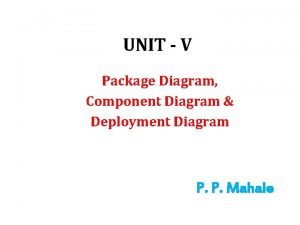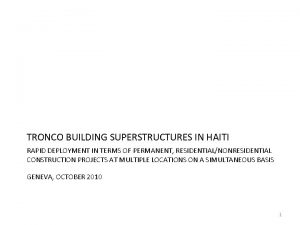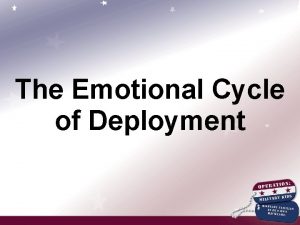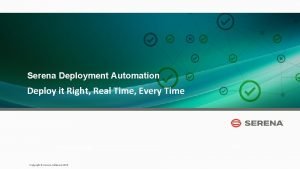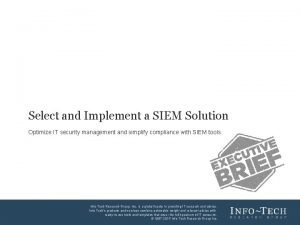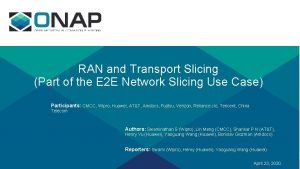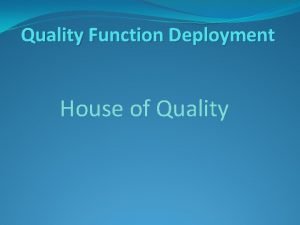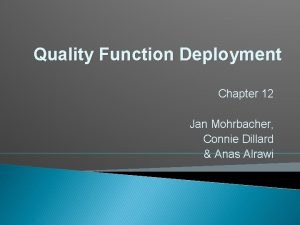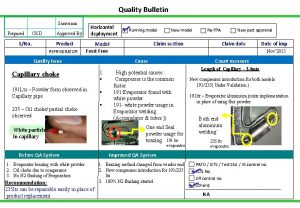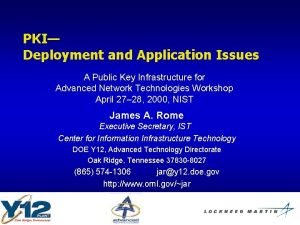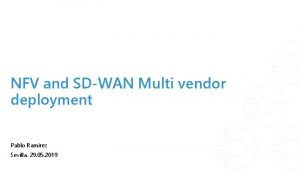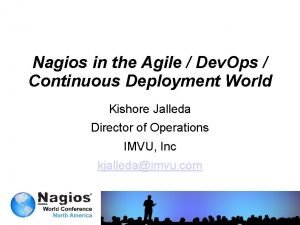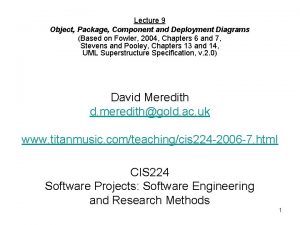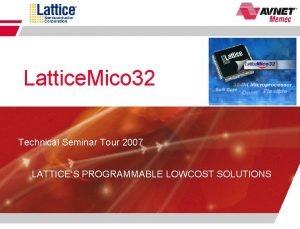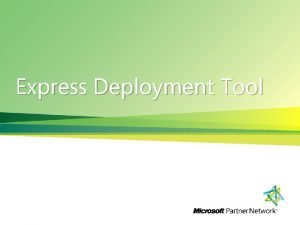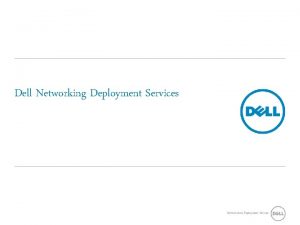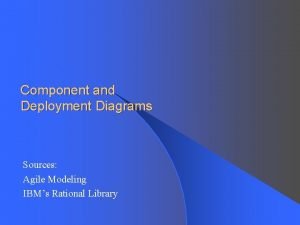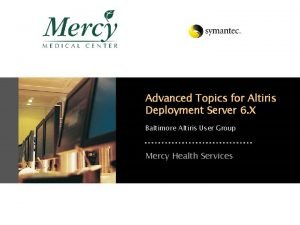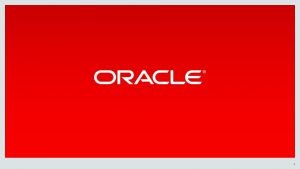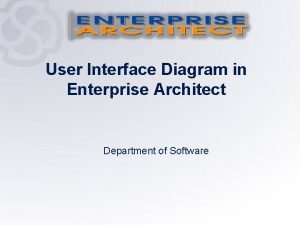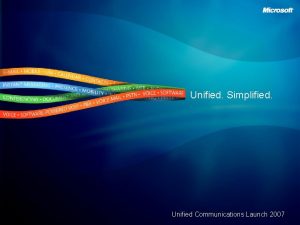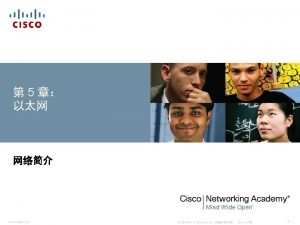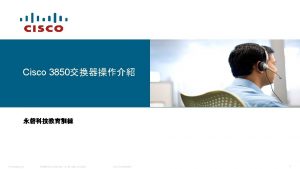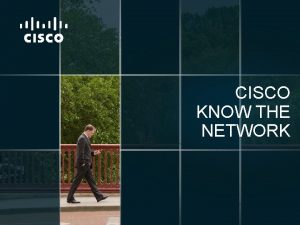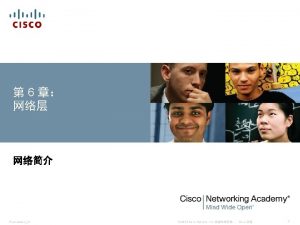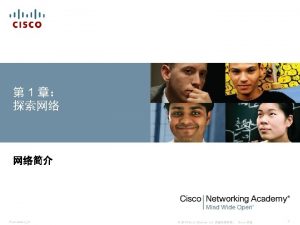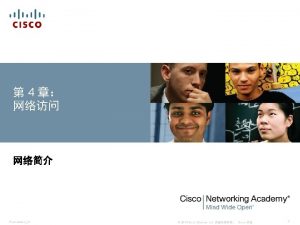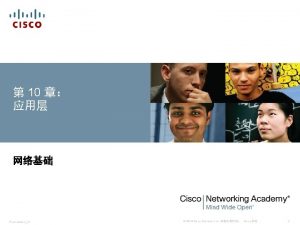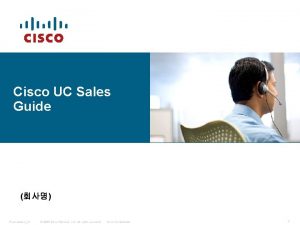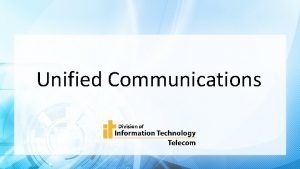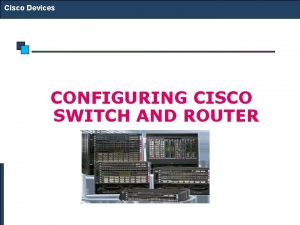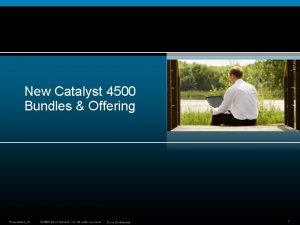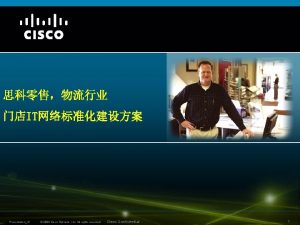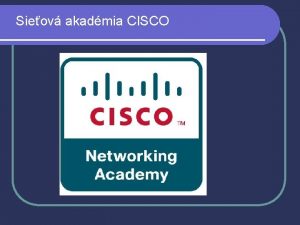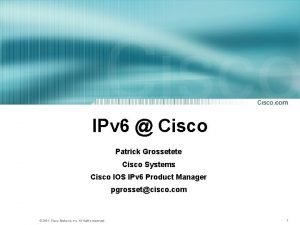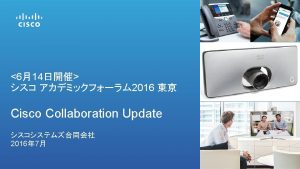Unified Communications Design and Deployment PresentationID 2009 Cisco












































































- Slides: 76

Unified Communications Design and Deployment Presentation_ID © 2009 Cisco Systems, Inc. All rights reserved. Cisco Public 1

Agenda Reference UC Architecture Call Processing Endpoints and Basic Call Gateways Media Resources Call Admission Control Dialplan Features TECVVT-1001 © 2009 Cisco Systems, Inc. All rights reserved. Cisco Public 2

Reference UC Architecture Remote Sites M -30 Users Max per site Regional Office -700 Users M MPLS M DS 3 M M Headquarters -3000 Users TECVVT-1001 © 2009 Cisco Systems, Inc. All rights reserved. M Cisco Public 3

Network Infrastructure Recommendations for Unified Communications Unified CM Cluster PSTN SRST Router IP WAN Bandwidth Provisioning Campus Access Campus Distribution WAN Aggregation Branch Office Branch Router Branch Switch Inline power Multiple Qs Inline Power Multiple Qs 802. 1 p/Q Multiple Qs 802. 1 p/Q Fast link Convergence Classification Reclassification Traffic Shaping Link Efficiency (LFI, c. RTP) Classification Reclassification 802. 1 p/Q TECVVT-1001 © 2009 Cisco Systems, Inc. All rights reserved. Cisco Public 4

Where To Get More Information Network Infrastructure Chapter Cisco Unified Communications SRND Based on Cisco Unified Communications Manager (One exists for each major release 4. x, 5. x, 6. x, etc…) Where is the SRND? http: //www. cisco. com/go/designzone Design Zone for Unified Communications TECVVT-1001 © 2009 Cisco Systems, Inc. All rights reserved. Cisco Public 5

Agenda Reference UC Architecture Call Processing Endpoints and Basic Call Gateways Media Resources Call Admission Control Dialplan Features TECVVT-1001 © 2009 Cisco Systems, Inc. All rights reserved. Cisco Public 6

Call Processing Overview Call Processing is… § The sequence of operations performed by a switching system from the acceptance of an incoming call through the final disposition of the call. TECVVT-1001 © 2009 Cisco Systems, Inc. All rights reserved. Cisco Public 7

Call Processing Cisco Call Processing Entities for the Enterprise § Large Business • Unified Communications Manager (Unified CM) Ø Up to 60, 000 phones per cluster Ø > 30 K, distributed architecture can include multiple clusters § Medium-Small Business • Unified Communications Manager Business Edition (Unified CMBE) Ø Up to 575 phones per server Ø Server platform, No Clustering Ø Co-Res with Unity Connection option • Unified Communications Manager Express (Unified CME) Ø Up to 240 phones per server Ø IOS Router platform, No Clustering Ø Co-Res with Cisco Unity Express option TECVVT-1001 © 2009 Cisco Systems, Inc. All rights reserved. Cisco Public 8

Call Processing Media Convergence Servers + = § Unified CM is installed on a Cisco Media Convergence Server (MCS) or VMWare ESX on UCS § Unified CM 4. x: Cisco Windows OS (two CDs) + Unified CM application § Unified CM 5. x/6. x/7. x/8. x: Cisco appliance-based OS and Unified CM application (one DVD) § First server in cluster must be the Publisher server TECVVT-1001 © 2009 Cisco Systems, Inc. All rights reserved. Cisco Public 9

Call Processing Unified CM Clustering: DB Replication and ICCS Unified CM Cluster Publisher Database (DB) Replication DB DB CTI Manager DB ccm. exe DB ICCS DB ccm. exe Mo. H Server DB TFTP Server DB ccm. exe DB Software Conferencing MS-SQL/IDS Subscribers (Max. 19) Unified CM 4. x: Call Processing Servers (Max. 8) DB=MS-SQL | OS=MS W 2 K Server Unified CM 5. x+: DB=IBM-IDS | OS=Linux TECVVT-1001 © 2009 Cisco Systems, Inc. All rights reserved. Cisco Public 10

Call Processing Unified CM Clustering: Design Considerations § The cluster appears as one entity, with a single point of administration (the publisher) § Several functions can be collocated on the same server, depending on cluster size and server type § Maximum of 19 subscribers per cluster (20 servers in a cluster including the publisher) § Maximum of eight call processing servers per cluster § Maximum of 7500 IP Phones per Cisco Unified CM server (server platform dependant) § Maximum of 60, 000 IP Phones per Cisco Unified CM cluster (server platform and configuration dependant) TECVVT-1001 © 2009 Cisco Systems, Inc. All rights reserved. Cisco Public 11

Call Processing Unified CM Clustering Capacities § Unified CM Approximate Sizing Server Platform Maximum Users per Server High Availability Server MCS 7845 7500 Yes MCS 7835 2500 Yes MCS 7825 1000 No § Cisco Unified Communications Sizing Tool http: //tools. cisco. com/cucst • Accessible to Cisco and Partners only • Good for you to know about! TECVVT-1001 © 2009 Cisco Systems, Inc. All rights reserved. Cisco Public 12

Unified CM Call Processing Deployment Models ‘Call Processing’-Based Deployment Models are dictated by: § Physical Location of Unified CM cluster Servers § Physical Location of Unified CM cluster IP Phones § Number of Unified CM clusters TECVVT-1001 © 2009 Cisco Systems, Inc. All rights reserved. Cisco Public 13

Unified CM Deployment Models Single Site § Unified CM, applications and DSP resources at same physical location Applications (VMail, IPCC, MP…) § Supports up to 30, 000 SIP or SCCP phones per cluster Unified CM Cluster § PSTN used for all external calls PSTN TECVVT-1001 © 2009 Cisco Systems, Inc. All rights reserved. Cisco Public 14

Deployment Models Centralized Call Processing Applications (VMail, IPCC, MP…) PSTN SRST-Enabled Routers Unified CM Cluster IP WAN Branch A Headquarters § Unified CM cluster at central/HQ site § Applications and DSP resources can be centralized or distributed Branch B § Supports up to 60, 000 SIP or SCCP phones per cluster § If WAN is “busy”, transparent use of PSTN (Automated Alternate Routing—AAR) § Survivable Remote Site Telephony (SRST) for remote branches § Maximum 1000 sites per cluster (500 prior to Unified CM 6. x) TECVVT-1001 © 2009 Cisco Systems, Inc. All rights reserved. Cisco Public 15

Deployment Models Distributed Call Processing (Unified CM-Unified CM Model) Applications (VMail, IPCC, MP…) Applications PSTN Unified CM Cluster GK Unified CM Cluster IP WAN Regional Branch A Headquarters GK Gatekeeper § Unified CM, applications, and DSPs located at each site § Up to 60, 000 SIP or SCCP phones per cluster Applications Unified CM Cluster § ~100 sites § Transparent use of PSTN if IP WAN unavailable § Each cluster can be single site or centralized call processing topology TECVVT-1001 © 2009 Cisco Systems, Inc. All rights reserved. Cisco Public Regional Branch B 16

Deployment Models Clustering over the WAN (Co. W) Unified CM Cluster Voice Mail San Jose Voice Mail Distance San Francisco § Unified CM servers in a cluster separated by WAN for spatial redundancy § Applications may be located at each site, thus separated by WAN § Single point of administration, feature transparency (e. g. Extension Mobility), unified dial plan Increased to 80 -ms RTT in 6. 1 § Maximum 40 -ms round-trip delay between any two Unified CM across the WAN § 900 kbps bandwidth for each 10, 000 BHCA between sites § Maximum of eight active locations TECVVT-1001 © 2009 Cisco Systems, Inc. All rights reserved. Cisco Public B/W Required Increased in 6. 1 17

Unified CM Call Processing Failover and Redundancy Gateways Unified CM Subscriber DSP Resources Conferencing Conf DSP Resources Transcoding Xcode F d e l ai Intra-Cluster Communications (ICCS) Cisco Unity Vmail Server Unified CM Subscriber JTAPI IP-IVR Active Unified CM Server IP Phones TECVVT-1001 © 2009 Cisco Systems, Inc. All rights reserved. Cisco Public Directory Services Music on Hold Software Conferencing Software MTP TFTP Call Processing CTI/QBE I/F SCCP I/F MGCP I/F H. 323 I/F SIP I/F 18

Unified CM Redundancy 1: 1 vs. 2: 1 Redundancy MCS 7835 Supports 2500 Phones/Server 2: 1 Redundancy Scheme Backup 1 to 2500 2501 to 5000 1: 1 Redundancy Scheme 1 to 1250 1251 to 2500 2501 to 3750 3751 to 5000 § Cost-efficient redundancy § Load-sharing redundancy § High Availability during upgrades § Maximum of 10, 000 backup registrations/server § Faster failover TECVVT-1001 © 2009 Cisco Systems, Inc. All rights reserved. Cisco Public 19

Unified Communications Infrastructure Failover and Redundancy: 1: 1 Redundancy Example ary Prim Backu p Backu ary Prim Phone Set 1 To 7, 500 IP Phones Phone Set 2 1 to 3750: Primary 3751 to 7500: Backup 3751 to 7500: Primary 1 to 3750: Backup © 2009 Cisco Systems, Inc. All rights reserved. § Load-share between primary and backup servers To 15, 000 IP Phones Publisher and TFTP Server(s) TECVVT-1001 § MCS 7845 supports 7500 phones/server p Publisher and TFTP Server(s) 1– 3750 7501– 11, 250 Cisco Public 3751– 7500 11, 251– 15, 000 To 30, 000 IP Phones Publisher and TFTP Server(s) 1– 3750 3751 to 7500 7501– 11, 250 11, 251– 15, 000 15, 001– 18, 250 18, 251– 22, 500 22, 501– 26, 250 26, 251– 30, 000 20

Unified Communications Infrastructure Failover and Redundancy: Survivable Remote Site Telephony Normal WAN Operation Failure Signaling Traffic Unified CM Cluster Signaling Traffic IP WAN Branch Site SRST Capable Router Voice Traffic PSTN Applications Central Site Voice Traffic § IP Phones have SRST router IP as the last option in their CM GROUP configuration § Support for both SIP and SCCP IP Phones § With SRST, only a subset of features are available to the phones (DID, DOD, call hold, transfer, speed dial, caller ID, etc. ) § H 323 PSTN GW connectivity option during failure modes via Vo. IP/POTS dial-peers; MGCP GWs require the ‘MGCP Fallback to H 323’ feature TECVVT-1001 © 2009 Cisco Systems, Inc. All rights reserved. Cisco Public 21

Agenda Reference UC Architecture Call Processing Endpoints and Basic Call Gateways Media Resources Call Admission Control Dialplan Features TECVVT-1001 © 2009 Cisco Systems, Inc. All rights reserved. Cisco Public 23

Unified Communications Core: Endpoints and Basic Call Topic Overview § Endpoints Not just phones—but all devices that terminate and originate IP telephony sessions: Gateways, MCUs, etc. , in addition to user phones Come with various capabilities and support varied protocols Phones interface directly with users and define User Experience § Network Services Provides functions other than Call Control such as: Inline Power, Device Discovery and Authentication, VLAN settings, IP Addressing, and other operating parameters § Line Side and Trunk Side Protocols Call control protocols and initiate, negotiate, and tear down calls Line side protocols enable user facing services and have richer feature support Trunk side enables connectivity with other telephony systems and application servers and interoperability is a prime criteria TECVVT-1001 © 2009 Cisco Systems, Inc. All rights reserved. Cisco Public 24

思科IP电话终端一览 9900 Series 8900 Series Voice 7900 Series SPA 500 Series SPA 9000 TECVVT-1001 SPA 500 Series UC-500 © 2009 Cisco Systems, Inc. All rights reserved. 7900 Series 6900 Series 3900 Series Unified CMBE CME on ISR Cisco Public PORTFOLIO AVG LIST PRICE ($USD) Voice/ Video/ Apps IP PHONE APPLICATIONS Higher 7900 Series Lower Unified CM 25

Unified Communications Core: Network Services IP Phone Boot-Up Process 1. Inline Power (ILP) Inline Power Initialization 2. Cisco Discovery Protocol (CDP) or Link Layer Discovery Protocol-Media Endpoint Discovery (LLDP-MED) ILP Negotiation, Voice VLAN ID 3. Dynamic Host Configuration Protocol (DHCP) IP Assignment, TFTP Server Allocation, DNS (optional) 4. Trivial File Transfer Protocol (TFTP) Configuration File, IP Phone Firmware TECVVT-1001 © 2009 Cisco Systems, Inc. All rights reserved. Cisco Public 26

Unified Communications Core: Network Services DHCP Inline Power Provided Cisco Catalyst Switch CDP/LLDP Neighbored DHCP Req DHCP Rsp (IP Add, Def-GW, TFTP, DNS*) DHCP Server Option 150 or Option 66 § Phone displays: “Configuring IP” (DNS is optional) DHCP Request Must Be Made in the Correct VLAN to Place the Phone in the Correct Subnet!! § Phone settings: Settings=>Net. Cfg=>“DHCP Server” Settings=>Net. Cfg=>“IP Address” Settings=>Net. Cfg=>“TFTP Server X” TECVVT-1001 © 2009 Cisco Systems, Inc. All rights reserved. Cisco Public 27

Unified Communications Core: Network Services TFTP Unified CM Cluster UCM 1 UCMx Registr ation (S CCP, SI MAC Address: 001956 A 6 A 7 ED UCM 2 P) Backup Link Publisher TFTP: GET Configuration File(s) for MAC Phone Configuration, Firmware Download (If Required) 1=UCM 1: 10. 1. 1. 1 2=UCM 2: 10. 1. 1. 2 … CM Group: UCM 1 UCM 2 Device Pool TECVVT-1001 © 2009 Cisco Systems, Inc. All rights reserved. Cisco Public 28

Unified Communications Core: Basic Call Centralized Deployment Model IP Phone to IP Phone Example § Call Processing is essentially the same in this deployment model as in the single site case; IP makes the technology more topology independent IP Phone A g 1 ing Le l a n g i S Unified CM Media IP WAN Dial Plan Lookup Sign aling Leg 2 IP Phone B TECVVT-1001 © 2009 Cisco Systems, Inc. All rights reserved. Cisco Public 29

Unified Communications Core: Network Services Signaling Protocols Gateways Unified CM 5. x+ Unified CME Conf/ Xcode Carriers/ Other Vendors PBXs Unified CM 5. x+ DSP Resources Cisco Unified Presence Server Rich-Media Conferencing Soft Phones Unified Messaging Microsoft LCS/OCS IBM Sametime CTI Apps Cisco and 3 rd-party Phones Video Endpoints Cisco Unified Personal Communicator Cisco Unified Communications provides seamless interworking with SIP, H. 323, MGCP, SCCP, TAPI/JTAPI and Q. SIG Protocols TECVVT-1001 © 2009 Cisco Systems, Inc. All rights reserved. Cisco Public SCCP MGCP H. 323 CTI SIP/SIMPLE CSTA over SIP 30

Unified Communications Core: Network Services Signaling Protocols: Unified CM as “Protocol Translator” Session Initiation Protocol ce Skinny Client Control Protocol ep Tel en res IP Phones ITU-T H. 323 Standard SIP Networks IP Phones Gateways Analog Phones Wireless IP Phones SIP Analog Phones PC-Based IP Phones SCC 3 H. 32 P Media Gateway Control Protocol Gateways MG CP © 2009 Cisco Systems, Inc. All rights reserved. Video Terminals Computer Telephony Integration/ Quick Buffer Encoding CT I/Q BE Applications Servers (JTAPI/CTI) Analog Phones TECVVT-1001 Gateways Call Agents Cisco Public 31

Unified Communications Core: Endpoints and Basic Call Reference Requirements and Recommendations § Endpoint Selection Executive full featured phones; some with video Conference rooms with high quality speaker phones Deskphones with services § Inline Power for Phones Use Compatible access switches § VLAN assignment Keep the Voice and Data networks separated out § DHCP Addressing Use a central DHCP server and independent servers in larger branches; keep address lease times large in branches using central server § TFTP Server Single TFTP Server co-resident with Publisher TECVVT-1001 © 2009 Cisco Systems, Inc. All rights reserved. Cisco Public 32

Unified Communications Core Endpoints and Basic Call Use Central DHCP Server Integrated DHCP Server MPLS Publisher & TFTP Server Independent Central DHCP Server 2 nd TFTP Server TECVVT-1001 © 2009 Cisco Systems, Inc. All rights reserved. Cisco Public 33

Agenda Reference UC Architecture Call Processing Endpoints and Basic Call Gateways Media Resources Call Admission Control Dialplan Features TECVVT-1001 © 2009 Cisco Systems, Inc. All rights reserved. Cisco Public 34

Unified Communications Core: Gateways and CUBE Topic Overview § Gateways Convert between IP and TDM Networks for PSTN access Distinguished by capacity, technology, IP Telephony protocol, services (fax, modem, video, etc. ) § Cisco Unified Border Element Formerly known as Multi-service IP-IP Gateway Used as a demarcation point between two IP Telephony networks— such as between the enterprise and IP telephony provider § Deployment Models Centralized: All PSTN access through the main HQ Distributed: Each site has local PSTN access; with both centralized or distributed call control Hybrid: A optimization of the above TECVVT-1001 © 2009 Cisco Systems, Inc. All rights reserved. Cisco Public 35

Unified Communications Core: Gateways Gateway Selection Criteria Cisco Unified CM PSTN Router/ Gateway IP WAN § Voice port density requirements § Signaling protocol (H. 323, MGCP, SIP, etc. ) § Support for required PSTN signaling types § Support for required WAN interfaces and Qo. S TECVVT-1001 © 2009 Cisco Systems, Inc. All rights reserved. Cisco Public 36

Unified Communications Core: Gateways H. 323 TDM IP PSTN PRI Layer 3 Layer 2 Framing H. 225 H. 245 Cisco Unified CM § All PSTN signaling terminates on gateway § H. 225 communication between gateway and Cisco Unified CM § H. 323 is a “peer-to-peer” protocol: each side can make decisions TECVVT-1001 © 2009 Cisco Systems, Inc. All rights reserved. Cisco Public 37

Unified Communications Core: Gateways The Power of Cisco IOS Dial-Peers: H. 323 and SIP PSTN dp 10 pots dp 1 voip dp 11 pots dp 2 voip dp 12 pots dp 3 voip IP Dial-Peers Allow You to: § Switch calls intelligently if required (interpret the dial plan) § Digit manipulation (called, calling and numbering plan) § Failover (preferences) to alternate destinations § Load balancing § Video ISDN switching § Insert applications into the call path: TCL/VXML Build support for signaling variations (e. g. CLID on T 1 CAS) Hookflash trunk release on FXO VXML call control for call centers Redistribute calls-in-q for CVP AA in the GW TECVVT-1001 © 2009 Cisco Systems, Inc. All rights reserved. Cisco Public These Capabilities Do Not Exist for MGCP-Controlled GWs 38

Unified Communications Core: Gateways Protocol and Platform Recommendations Designing UC Gateways and DSP Engineering in Enterprise Networks Cisco Unified CM Cluster PSTN SRST Router BRKVVT-2010 Router/ Gateway IP WAN Central Site Remote Site § H. 323, SIP, MGCP fallback to H. 323/SIP § Standalone, Router-integrated § MGCP, SIP, H. 323 § Standalone, Router-integrated § Platforms: WS-X 6608, CMM 26 XX, 28 XX 37 XX, 38 XX § Platforms: 17 XX, 18 XX 26 xx, 28 XX 37 xx, 38 xx TECVVT-1001 © 2009 Cisco Systems, Inc. All rights reserved. Cisco Public 39

Cisco Unified Border Element Key Features CUBE Session Mgmt Demarcation Fault isolation Topology Hiding Network Borders L 5/L 7 Protocol Demarc Statistics and Billing Real-time session Mgmt Call Admissions Control Ensuring Qo. S PSTN GW Fallback Statistics and Billing Redundancy/Scalability Interworking Yours H. 323 and SIP Normalization DTMF Interworking Transcoding Codec Filtering Fax/Modem Support TECVVT-1001 © 2009 Cisco Systems, Inc. All rights reserved. Mine Cisco Public Security Encryption Authentication Registration SIP Protection FW Placement Toll fraud 40

Unified Communications Core: Cisco Unified Border Element Usage in IP-PSTN Connectivity Cisco Unified Communications Manager Cluster Cisco Unified Border Element H. 323/SIP Trunk SBC IP-PSTN Service Provider SIP Trunk § Network/Topology Hiding for Voice and Video Calls § Signaling Interworking § Protocol Support—H. 323 and SIP § Supplementary Services § Voice Codecs—G. 711, G. 729, G. 726, G. 723, G. 728, Transparent § Transcoding § Video Codecs—H. 261, H. 263 and H. 264 § Transport Mode—TCP, UDP § Codec Filtering § Number Translation § Media—Media Flow Through and Media Flow Around § Quality of Service § DTMF Interworking—H. 245 Alphanumeric, Signal, RFC 2833, SIP NOTIFY § Call Admission Control § Call Detail Records § TCL/VXML Support § Rotary Support § Fax/Modem—T. 38, Passthrough, Cisco Fax Relay, Modem Passthrough § Security—TLS, IPSec with SRTP TECVVT-1001 © 2009 Cisco Systems, Inc. All rights reserved. Cisco Public 41

Unified Communications Core: Cisco Unified Border Element BRKVVT-2305 Integrating Voice and Video over IP Networks Using the Cisco Unified Border Element Address Hiding 192. 168. 10. 50 10. 10. 5 10. 10. 6 CUBE Cisco Unified CM Cluster 192. 168. 10 CUBE IP WAN Site A Unified Border Element Site A— 192. 168. 10. x/24 192. 168. 10. 50 IP WAN 10. 10. x/24 Site B Unified Border Element Cisco Unified CM Cluster Site B— 192. 168. 10. x/24 § Within the same company—between departments having overlapping addresses § Integrating new acquisition into the existing voice network TECVVT-1001 © 2009 Cisco Systems, Inc. All rights reserved. Cisco Public 42

Agenda Reference UC Architecture Call Processing Endpoints and Basic Call Gateways Media Resources Call Admission Control Dialplan Features TECVVT-1001 © 2009 Cisco Systems, Inc. All rights reserved. Cisco Public 43

Unified Communications Core: Media Resources Topic Overview § Role of Media Resources Necessary where any manipulation of media is required such as mixing (conference bridges), changing the compression type (transcoding), etc. § Types of Resources Hardware (DSP Based) Software (IOS Based) Software (IP Voice Media Streaming Application) § Deployment Models Centralized: Media flows to the central site over company WAN increasing BW requirements put perhaps save in hardware costs by aggregation Distributed: Save in WAN BW by local media services but perhaps at a higher cost TECVVT-1001 © 2009 Cisco Systems, Inc. All rights reserved. Cisco Public 44

Unified Communications Core: Media Resources Conferencing, Transcoding, Music on Hold IVR § Conference Bridge Cisco Unified CM Cluster Music on Hold DSPs needed for multicodec conferences § Media Termination Point Transcoder Xcode Media Termination MTP DSPs optional Conference Bridge Conf § Transcoding DSPs needed to transcode multiple CODEC types (e. g. , G. 711 to G. 729) PSTN IP WAN Automatic codec selection § Music on Hold Multiple source types possible (centralized or branch-based) TECVVT-1001 © 2009 Cisco Systems, Inc. All rights reserved. Cisco Public . . . 45

Unified Communications Core: Media Resources Media Resource Group Lists and Media Resource Groups User Needs Media Resource Manager Assigned to Device Directly or via Device Pool Media Resource Group List 1 st Choice Media Resource Group 1 st Choice Media Resource 1 TECVVT-1001 © 2009 Cisco Systems, Inc. All rights reserved. 2 nd Choice Media Resource 2 Cisco Public 2 nd Choice 1 st Choice Media Resource Group Media Resource 3 2 nd Choice Media Resource 4 46

Unified Communications Core: Media Resources MRGL and Device Association MRGL—A MRG—A Device Pool—A § CM Group § Date/Time Group Media Resources § Region § Media Resource Group List Site A MRGL—B MRG—B Media Resources Assign a MRGL Directly to the Device Take a Higher Priority than Device-Pool Based Configuration Device Pool—B § CM Group § Date/Time Group § Region § Media Resource Group List For Groups of Devices that Don’t Need Special Media Resources or Can’t Be Assigned a MRGL Directly Assign the MRGL via the Device Pool Site B TECVVT-1001 © 2009 Cisco Systems, Inc. All rights reserved. Cisco Public 47

Unified Communications Core: Media Resources Centralized vs. Distributed DSPs X Centralized DSPs Cisco Unified CM Cluster PSTN A IP WAN B Conf Branch Central Site $ Bandwidth vs. $ Hardware X Distributed DSPs A PSTN IP WAN B Branch TECVVT-1001 Cisco Unified CM Cluster © 2009 Cisco Systems, Inc. All rights reserved. Conf MRG Cisco Public Conf MRG Central Site 48

Unified Communications Core: Media Resources Key Takeaways § CFB, MTP, XCODE, MOH are media resources § Media Resource MRGL § Load Balance (round-robin) Similar Media Resources within an MRG § MRM walks through MRG in order top-down § Next MRG in MRGL is used required resource is exhausted or has failed (unregistered) TECVVT-1001 © 2009 Cisco Systems, Inc. All rights reserved. Cisco Public 49

Unified Communications Core Media Resources dsp dsp MPLS dsp dsp dsp TECVVT-1001 © 2009 Cisco Systems, Inc. All rights reserved. Cisco Public 50

Agenda Reference UC Architecture Call Processing Endpoints and Basic Call Gateways Media Resources Call Admission Control Dialplan Features TECVVT-1001 © 2009 Cisco Systems, Inc. All rights reserved. Cisco Public 51

Call Admission Control Why Is It Needed? Circuit-Switched Networks Packet-Switched Networks IP WAN PSTN Physical Trunks IP WAN Link Third Call Rejected PBX Router/ Gateway STOP IP WAN Link’s LLQ Is Provisioned for Two Calls (Equivalent to Two “Virtual” Trunks) No Physical Limitation on IP Links UC Third Call Can Go Through, Manager but Voice Quality of All Calls Degrades Call Admission Control Blocks Third Call TECVVT-1001 © 2009 Cisco Systems, Inc. All rights reserved. Cisco Public 52

Unified Communications Core Call Admission Control Two Types of CAC: BRKRST-2505 Call Admission Control Design for Unified Communications BRKVVT-3303 Advanced Call Admission Control Design, Implementation, and Troubleshooting Using RSVP A. Topology-Unaware B. Topology-Aware Three Options for Configuring CAC: 1. Unified CM Locations (Topology-Unaware) 2. RSVP (Topology-Aware) 3. Gatekeeper Zones (Topology-Unaware) TECVVT-1001 © 2009 Cisco Systems, Inc. All rights reserved. Cisco Public 53

Unified CM Static Locations Concept Central Site § Prevent WAN link oversubscription by limiting voice bandwidth <Hub_None> Location § Assign bandwidth limit for voice per location (G 729 = 24 Kbps, G 711=80 Kbps) § Location 1 makes a G 729 call over WAN to the Central Site IP WAN PSTN 1 Location 1 Max BW = 24 kbps Avail BW = 24 kbps TECVVT-1001 © 2009 Cisco Systems, Inc. All rights reserved. Cisco Public Remote Sites Location 2 Max BW = 48 kbps Avail BW = 48 kbps 54

Unified CM Static Locations Concept Central Site § Prevent WAN link oversubscription by limiting voice bandwidth <Hub_None> Location § Assign bandwidth limit for voice per location (G 729 = 24 Kbps, G 711=80 Kbps) § Location 1 makes a G 729 call over WAN to the Central Site § Location 1 attempts a G 729 call, but Locations-based CAC blocks the call § When resources are insufficient, by default the user hears a fast-busy tone and a configurable message is displayed TECVVT-1001 © 2009 Cisco Systems, Inc. All rights reserved. Cisco Public IP WAN PSTN 2 nd 2 STOP 1 Location 1 Max BW = 24 kbps Avail BW = 0 kbps Remote Sites Location 2 Max BW = 48 kbps Avail BW = 48 kbps 55

Unified CM Static Locations Concept Central Site § Prevent WAN link oversubscription by limiting voice bandwidth <Hub_None> Location § Assign bandwidth limit for voice per location (G 729 = 24 Kbps, G 711=80 Kbps) § Location 1 makes a G 729 call over WAN to the Central Site § Location 1 attempts a G 729 call, but Locations-based CAC blocks the call 2 nd § When resources are te a n r all e c t l s A insufficient, e user end ththe ted by) sdefault a m o R t (AA mlesstone Auto a hears fast-busy and a g n i t a e u Ro STN s message is configurable via P displayed r. use TECVVT-1001 © 2009 Cisco Systems, Inc. All rights reserved. Cisco Public 3 2 IP WAN PSTN STOP 1 Location 1 Max BW = 24 kbps Avail BW = 0 kbps Remote Sites Location 2 Max BW = 48 kbps Avail BW = 48 kbps 56

Unified CM Static Locations Bandwidth Provisioning Provision LLQ PQ with These Values Actual L 3 Bandwidth L 2 Bandwidth (Frame Relay) 80 Kbps (64 K + Header) 81. 6 Kbps (80 K + L 2 Header) 24 Kbps (8 K + Header) 25. 6 Kbps (24 K + L 2 Header) CUCM Location G. 711 Audio G. 729 Audio 384 K Video TECVVT-1001 © 2009 Cisco Systems, Inc. All rights reserved. 384 Kbps Cisco Public 420 Kbps (384 K + Est. L 2/L 3 Headers 57

Unified CM Static Locations Notes § Audio is represented as a static bit-rate + IP overhead (i. e. 24 k for G. 729, 80 k for G. 711) § Video is represented as a static bit-rate only (i. e. 384 k for a 384 k call) which includes the audio portion § The audio bandwidth setting does not pertain to the audio channel of a video call § If transcoders are needed (e. g. , in presence of G. 711 -only devices), the transcoder must be colocated with the G. 711 only device § The location setting on CTI route points is only used by Cisco Unified CM if an application registers to handle media with that route point TECVVT-1001 © 2009 Cisco Systems, Inc. All rights reserved. Cisco Public 58

Call Admission Control Simple Hub and Spoke Topologies: Centralized Deployments § Use Static Locations: one location per spoke site Hub Site § Devices at hub site in <Hub_None> location § Up to 1, 000 locations per Cisco Unified CM cluster Increased to 2000 in 7. 1 § If more than one Cisco Unified CM cluster at hub site, use Intercluster Trunks (leave in <Hub_None> location) § Location needs to be updated if device moves to a different site Loc. <Hub_None> . . . Loc. 1000 Spoke Sites TECVVT-1001 © 2009 Cisco Systems, Inc. All rights reserved. Cisco Public 59

Agenda Reference UC Architecture Call Processing Endpoints and Basic Call Gateways Media Resources Call Admission Control Dialplan Features TECVVT-1001 © 2009 Cisco Systems, Inc. All rights reserved. Cisco Public 60

Off-Cluster Routes in Unified CM Overall Structure Route Pattern § Matches dialed number for external calls § Points to a route list for routing § Performs digit manipulation (optional) Route List § Points to prioritized route groups § Performs digit manipulation (opt) Route Group 1 st Choice Route Group 1 2 nd Choice Route Group 2 1 st Choice § Points to the actual devices § Distribution algorithm IP WAN Devices § Gateways (MGCP, SCCP, H. 323) § Gatekeeper (H. 323) § Trunk (H. 323, ICT, SIP) TECVVT-1001 © 2009 Cisco Systems, Inc. All rights reserved. Cisco Public GK 2 nd Choice PSTN Configuration Order Route Pattern 61

Cisco Unified CM Call Routing Logic Commonly Used Wildcards Delimiter (Does Not Match Any Digits)—Used for Discarding Range of Digits (Between 2 and 9) Single Digit Between 0 and 9 9. [2 -9] XXXXXX One or More Occurrences of Digits Between 0 and 9 The “#” Digit—Used to Avoid Inter. Digit Timeout 9. 011! # 9. @ TECVVT-1001 A Macro That Enters the Whole North American Numbering Plan into Cisco Unified CM (or a Different Country’s Numbering Plan If Using the International Dial Plan Tool) © 2009 Cisco Systems, Inc. All rights reserved. Cisco Public 62

Cisco Unified CM Call Routing Logic Matching Patterns 1111 Matches 1111 *1*1 Matches *1*1 12 XX Matches Numbers Between 1200 and 1299 13[25 -8]6 Matches 1326, 1356, 1366, 1376, 1386 13[^3 -9]6 Matches 1306, 1316, 1326, 13*6, 13#6 13!# TECVVT-1001 Matches Any Number That Begins with 13, Is Followed by One or More Digits, and Ends with #; 135# and 13579# Are Example Matches © 2009 Cisco Systems, Inc. All rights reserved. Cisco Public 63

Cisco Unified CM Call Routing Logic Basic Principle Cisco Unified CM Call Routing Logic Route Patterns User Dials “ 1200” 1 XXX 12 XX Directory Numbers User Dials “ 1234” 1234 § Cisco Unified CM matches the most specific pattern (longest-match logic) § For call routing, an IP phone directory number acts as a ‘route pattern’ that matches a single number TECVVT-1001 © 2009 Cisco Systems, Inc. All rights reserved. Cisco Public 64

Building Classes of Service Concepts Partition. A CSS 1 Phones 2002 2001 2000 Partition. A Partition. B Lines (Directory Numbers) CSS 2 Lines Partition. B CSS 3 Gateways Partition. B Partition. A “Dialable” Patterns “Dialing” Devices 7 [Transform Mask: 2001] TECVVT-1001 Partition. A © 2009 Cisco Systems, Inc. All rights reserved. Cisco Public Route Patterns 9. [2 -9]XXXXXX Partition. B 5000 900 X 99 XX CSS 4 Applications 911 Translation Patterns Application Numbers (CTI Route Points, CTI Ports) Special numbers (Meet. Me, Call. Pickup. . . ) 8001 8000 Voice Mail Ports 9. 011! Route Patterns 65

Dial Plan Example Single Site Deployment Model: Composite View Calling Search Spaces Calling Search Space Assigned Partitions Internal All IP Phone DNs Route Groups Devices Route Patterns 911 9. 911 Internal Only Local Route Lists 9. [2– 9]XXXXXX LOC RL LOC RG 9. [2– 9]XXXXXX National 9. 1[2– 9]XXXXXX International PSTN International 2 LD RL LD RG 1 9. 011!# TECVVT-1001 © 2009 Cisco Systems, Inc. All rights reserved. Cisco Public 66

Dial Plan Example Centralized Deployment Model: Composite View Calling Search Space Assigned Calling Search Spaces NYC 911 9. 911 NYCInternal NYC Phones Partitions NYCAll. Calls Route Lists Route Groups Devices Route Patterns NYCPSTN 9. [2– 9]XXXXXX 9. 1[2– 9]XX[2 -9]XXXXXX 9. 011!# NYC PSTN NYC Gateways Internal All IP Phones PHLInternal PHL Phones TECVVT-1001 PHLAll. Calls © 2009 Cisco Systems, Inc. All rights reserved. PHL 911 9. 911 PHLPSTN 9. [2– 9]XXXXXX 9. 1[2– 9]XXXXXX 9. 011!# Cisco Public PHL PSTN PHL Gateways 67

Dial Plan Example Centralized Deployment Model: Composite View ~ Using Local Route Group feature of Unified CM version 7. 0 ~ Calling Search Space Assigned Calling Search Spaces NYCInternal Partitions Route Lists Route Groups Internal All IP Phones NYC Phones Devices NYCAll. Calls PSTN US EMERG 911 9. 911 US PSTN Local Route Group NYC Gateways US PSTN PHLInternal PHL Phones TECVVT-1001 PHLAll. Calls © 2009 Cisco Systems, Inc. All rights reserved. 9. [2– 9]XXXXXX 9. 1[2– 9]XX[2 -9]XXXXXX 9. 011!# Route Patterns Cisco Public PSTN Route group chosen as per device pool of calling device PHL Gateways 68

Local Route Group with it – key take aways § We go from route patterns that are site-specific to patterns that are type-specific. e. g. : local, national, international § We now group by dial plan domains e. g. : US dialing habits of 9 plus seven, 9 plus ten, 91 plus ten, 9011 plus ? ? ? , 911, 9911). I could not add a French site to the preceding example without creating patterns for 112, 00[16]XXXX, 000!# § We get site-specific failover for “free” on long distance patterns § We now have much fewer things to configure per site TECVVT-1001 © 2009 Cisco Systems, Inc. All rights reserved. Cisco Public 69

Unified Communications Core Dial Plan UC Reference Requirements and Recommendations Design Criteria: § Centralized Management § “ 9” PSTN Access Code § Three Classes of service § Centralized IP PSTN for Long Distance and International calling Design Recommendations: § Class of Service § Route Groups/Route Lists § Unified CM 7. x TECVVT-1001 © 2009 Cisco Systems, Inc. All rights reserved. Cisco Public 70

Translation Patterns Key Concept § Looks like a route pattern, allows digit manipulation § Instead of sending calls outside via a route list, forces second lookup in Cisco Unified CM, using a (possibly different) calling search space User Dials “ 0” to Reach Operator TECVVT-1001 © 2009 Cisco Systems, Inc. All rights reserved. Cisco Public Translation Pattern 0 2001 Translates “ 0” to 2001 and Forces a Second Lookup Ext. 2001 71

Translation Pattern Incoming IP WAN Calls Example Calling Search Spaces Partitions One TP per Unique DID Range “E 164_Translate” WAN 121255. 5 XXXX [Discard Pre. Dot] “Incoming” 140852. 6 XXXX [Discard Pre. Dot] 121555. 5 XXXX [Discard Pre. Dot] Translation Pattern Must Match the Incoming Called Number “Internal” 51000 51001 “Internal Only” 64000 Each TP Can Designate a Different Resulting CSS © 2009 Cisco Systems, Inc. All rights reserved. . TECVVT-1001 64001 Cisco Public 72

Agenda Reference UC Architecture Call Processing Endpoints and Basic Call Gateways Media Resources Call Admission Control Dialplan Features TECVVT-1001 © 2009 Cisco Systems, Inc. All rights reserved. Cisco Public 73

Extension Mobility Functionality § Extension Mobility (EM) is an application that allows a user to temporarily take ownership of a phone § User-specific device profile is configured for each EM user and applied to the phone a user logs in to § User can log in to any phone within a Unified CM cluster that has been enabled for EM Device Profile 62796 62798 Home Sue Mobile TECVVT-1001 © 2009 Cisco Systems, Inc. All rights reserved. Cisco Public 74

Extension Mobility EM Phone Service Login Extension Mobility Login/Logout Procedure: 1. User presses Services key on phone 2. Cisco Unified CM returns a list of subscribed services including Extension Mobility phone service 1 3. User selects and enters User. ID and PIN number and pushes submit to start login process (or selects ‘Yes’ softkey to start logoff) 3 Extension Mobility Login Extension Mobility jsmith 2 TECVVT-1001 © 2009 Cisco Systems, Inc. All rights reserved. Cisco Public 75

Mobility and Mobility Applications Unified Mobility—Mobile Connect, SNR Call Rings Remote Destination 408 555 -7890 Enterprise Call to Remote Destination 408 555 -7890 Routed via Gateway 6 408 555 -7890 PSTN Gateway Cisco Unified CM Cluster 5 Remote Destination: 408 555 -7890 PSTN Call Placed to Associated Remote Destination 408 555 -7890 1 Dials: 1 408 555 -1234 Phone A 2 Remote Destination Profile Call Extended to Desk Phone Mobile User’s Enterprise DN 4 DN: 408 555 -1234 Call Extended to Remote Destination Profile DN: 408 555 -1234 Shared Line 3 Call to mobile user’s Enterprise directory number rings at desk phone and Remote Destination phone: Note: No Changes Are Required on § Call can be answered at either phone Mobility User’s Remote Destination Phone § Once answered all other call legs are cleared TECVVT-1001 © 2009 Cisco Systems, Inc. All rights reserved. Cisco Public 76

Mobility and Mobility Applications Unified Mobility—Remote Destination and Desk Phone Pickup Remote Destination Pickup Call Rings Remote Phone; Once Answered, Call Continues Uninterrupted Between Caller and Remote Phone User Presses Mobility Softkey and then Select Softkey to Pickup on Remote Destination Phone 3 PSTN Gateway 5551234 Mobile. Connect On jsmith 2 408 555 -7890 PSTN DN: 408 555 -1234 1 Phone A Enterprise Mobile Connect Call Answered and in Progress at Desk Phone Once Mobile Connect call is in progress there are two types of pickup: 1. Remote Destination Pickup: Mobile user can pickup inprogress desk phone call at Remote Destination phone 2. Desk Phone Pickup: Mobile user can pickup in-progress remote phone call at TECVVT-1001 © 2009 Cisco Systems, Inc. All rights reserved. Desk Phone Pickup Mobile Connect Call Answered and in Progress at Remote Destination 1 Upon Remote Destination Hang Up (or Mid-Call Hold) User Can Pickup at Desk Phone by Pressing the Resume Softkey PSTN Gateway 408 555 -7890 2 PSTN 3 Phone A Cisco Public Call Continues Uninterrupted Between Caller and Desk Phone DN: 408 555 -1234 Enterprise 77
 Cisco unified communications manager tutorial
Cisco unified communications manager tutorial Cisco uci
Cisco uci Hosted collaboration services
Hosted collaboration services Processing model
Processing model Unified communications open source
Unified communications open source Open platform communications unified architecture
Open platform communications unified architecture Who are puma unified communications
Who are puma unified communications Asterisk instant messaging
Asterisk instant messaging Oma-dm client high cpu
Oma-dm client high cpu Bt cloud vo
Bt cloud vo Unified communications roadmap
Unified communications roadmap Hp unified communications
Hp unified communications Unified communications evolution
Unified communications evolution Unified communications for financial services
Unified communications for financial services Virtual reality unified communications
Virtual reality unified communications Unified communication
Unified communication Who are puma unified communications
Who are puma unified communications Hosted voip
Hosted voip Unified communications command suite
Unified communications command suite Grapevine unified communications
Grapevine unified communications Unified communications infrastructure
Unified communications infrastructure Who are puma unified communications
Who are puma unified communications Cisco mcs 7800 end of life
Cisco mcs 7800 end of life Cisco unity connection unified messaging troubleshooting
Cisco unity connection unified messaging troubleshooting Unified mobility
Unified mobility Cisco unified contact center management portal
Cisco unified contact center management portal Contact center management portal
Contact center management portal Cisco unified cm assistant console
Cisco unified cm assistant console Cisco unified callconnector
Cisco unified callconnector Cisco unified callconnector
Cisco unified callconnector Cisco personal communications assistant
Cisco personal communications assistant Pilot intune
Pilot intune Information design: a unified perspective
Information design: a unified perspective Communications network design
Communications network design Persistence in component diagram
Persistence in component diagram Apdex
Apdex Hybrid sales organization structure
Hybrid sales organization structure Power bi governance and deployment
Power bi governance and deployment Component in deployment diagram
Component in deployment diagram Salesforce organization structure
Salesforce organization structure Deployment and component diagram
Deployment and component diagram Power bi governanace
Power bi governanace Expressway clustering
Expressway clustering Cisco borderless switched network design
Cisco borderless switched network design Discrepancy matrix morrison and wonnacott 2009
Discrepancy matrix morrison and wonnacott 2009 Coroners and justice act
Coroners and justice act Saunders lewis and thornhill 2009
Saunders lewis and thornhill 2009 How to draw 1/5
How to draw 1/5 Tarpaulin unified products and services logo
Tarpaulin unified products and services logo Object based and unified storage
Object based and unified storage In 479 bc a large unified greek army
In 479 bc a large unified greek army S and a unified home care
S and a unified home care Object based and unified storage
Object based and unified storage Deployment descriptor
Deployment descriptor Wordpress deployment automation
Wordpress deployment automation Common modeling techniques of deployment diagram
Common modeling techniques of deployment diagram Tronco system
Tronco system Cycle of deployment
Cycle of deployment Serena deployment automation pricing
Serena deployment automation pricing Siem implementation steps
Siem implementation steps Greenfield vs brownfield deployment
Greenfield vs brownfield deployment Quality function deployment diagram
Quality function deployment diagram Jan mohrbacher
Jan mohrbacher Horizontal deployment system
Horizontal deployment system Policy deployment
Policy deployment Lab 14-9 work with pki
Lab 14-9 work with pki Contoh component diagram
Contoh component diagram Adva cpe
Adva cpe Imvu continuous deployment
Imvu continuous deployment Physical deployment diagram
Physical deployment diagram Lattice mico
Lattice mico Windows express deployment tool
Windows express deployment tool Infrastructure deployment services
Infrastructure deployment services Component diagram example
Component diagram example Altiris deployment server
Altiris deployment server Maximum availability architecture
Maximum availability architecture User interface diagram
User interface diagram
